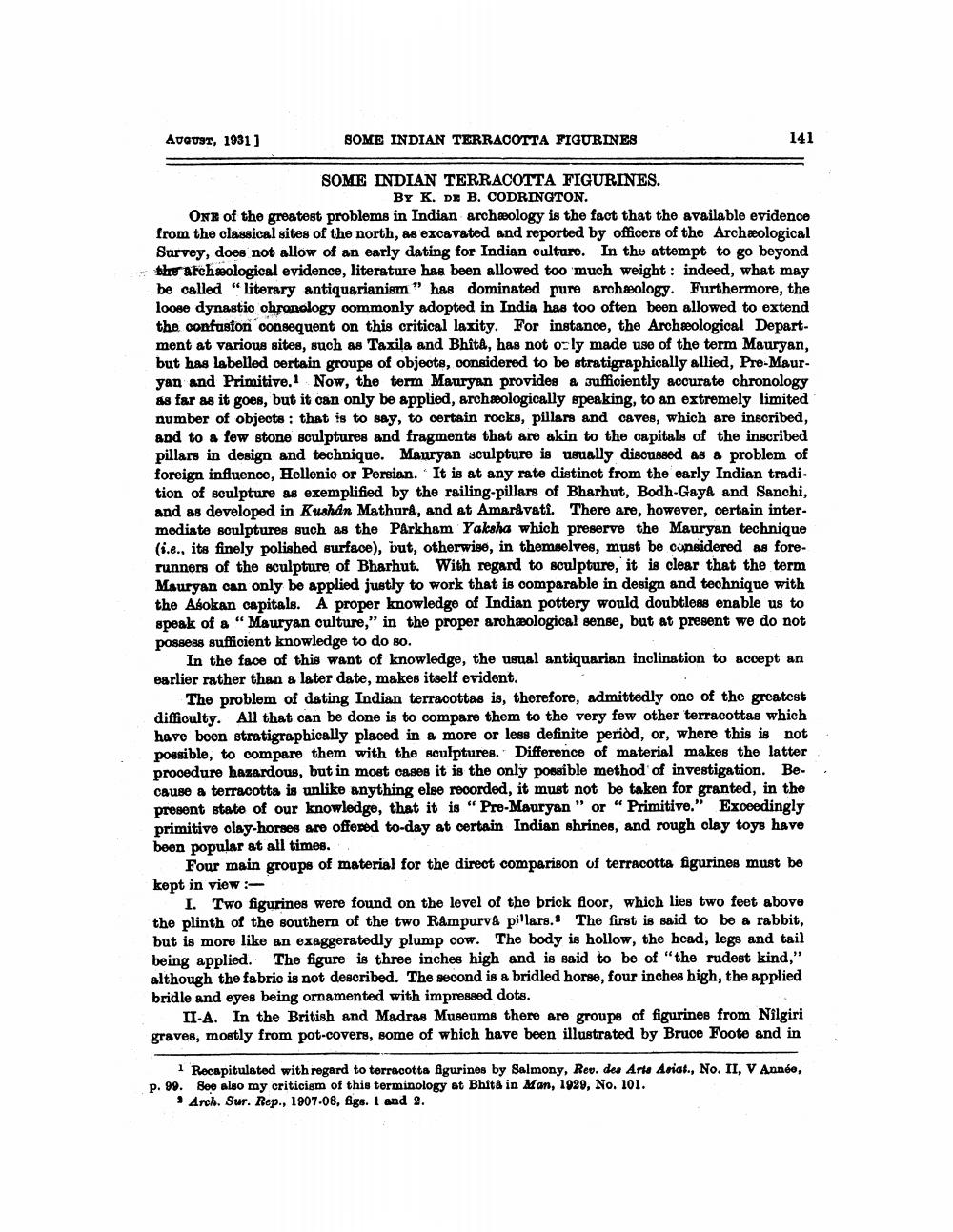________________
August, 1931)
SOME INDIAN TERRACOTTA FIGURINES
141
SOME INDIAN TERRACOTTA FIGURINES.
BY K. DE B. CODRINGTON. One of the greatest problems in Indian archæology is the fact that the available evidence from the classical sites of the north, as excavated and reported by officers of the Archæological Survey, does not allow of an early dating for Indian culture. In the attempt to go beyond the archæological evidence, literature has been allowed too much weight: indeed, what may be called "literary antiquarianism" has dominated pure archæology. Furthermore, the loose dynastio chronology commonly adopted in India has too often been allowed to extend the oonfusion consequent on this critical laxity. For instance, the Archeological Department at various sites, such as Taxila and Bhita, has not odly made use of the term Mauryan, but has labelled certain groups of objeots, considered to be stratigraphically allied, Pre-Mauryan and Primitive. 1 Now, the term Mauryan provides a cufficiently accurate chronology as far as it goes, but it oan only be applied, archeologically speaking, to an extremely limited number of objects: that is to say, to certain rocks, pillars and caves, which are inscribed, and to a few stone sculptures and fragments that are akin to the capitals of the inscribed pillars in design and technique. Mauryan sculpture is usually discussed as a problem of foreign influence, Hellenic or Persian. It is at any rate distinct from the early Indian tradition of sculpture as exemplified by the railing-pillars of Bharhut, Bodh-Gaya and Sanchi, and as developed in Kushan Mathura, and at Amaravati. There are, however, certain intermediate soulptures such as the Parkham Yaksha which preserve the Mauryan technique (i.e., its finely polished surface), but, otherwise, in themselves, must be considered as fore. runners of the sculpture of Bharhut. With regard to sculpture, it is clear that the term Mauryan can only be applied justly to work that is comparable in design and technique with the Asokan capitals. A proper knowledge of Indian pottery would doubtless enable us to speak of a "Mauryan culture," in the proper arohæological sense, but at present we do not possess sufficient knowledge to do so.
In the face of this want of knowledge, the usual antiquarian inclination to acoept an earlier rather than a later date, makes itself evident.
The problem of dating Indian terracottas is, therefore, admittedly one of the greatest difficulty. All that can be done is to compare them to the very few other terracottas which have been stratigraphically placed in a more or less definite period, or, where this is not possible, to compare them with the soulptures. Difference of material makes the latter prooedure hazardous, but in most cases it is the only possible method of investigation. Be-, cause a terracotta is unlike anything else recorded, it must not be taken for granted, in the present state of our knowledge, that it is "Pre-Mauryan " or “ Primitive." Exceedingly primitive olay-horses are offered to-day at certain Indian shrines, and rough clay toys have been popular at all times.
Four main groups of material for the direct comparison of terracotta figurines must be kept in view :
I. Two figurines were found on the level of the brick floor, which lies two feet above the plinth of the southern of the two Rampurva pillars. The first is said to be a rabbit, but is more like an exaggeratedly plump cow. The body is hollow, the head, legs and tail being applied. The figure is three inches high and is said to be of "the rudest kind," although the fabrio is not described. The second is a bridled horse, four inches high, the applied bridle and eyes being ornamented with impressed dots.
II-A. In the British and Madras Museums there are groupe of figurines from Nilgiri graves, mostly from pot-covers, some of which have been illustrated by Bruce Foote and in
1 Recapitulated with regard to terracotta figurines by Salmony, Rev. des Arts Arias., No. II, V Année, p. 99. See also my criticism of this terminology at Bhit& in Man, 1929, No. 101.
Arch. Sur. Rep., 1907-08, figs. 1 and 2.




